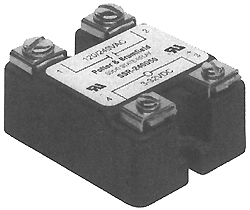 Call:
Call:414-327-1555
Fax : 414-327-0577
Email: indelect@execpc.com
Catalog, Quote, Availability.
 Call:
Call:

POTTER & BRUMFIELD SSR series "HOCKEY PUCK" SOLID STATE RELAY PAIRED SCR OUTPUT File E29244 File E29244 UL Recognized for Canada · Standard "hockey puck" package. · Inverse parallel SCR output. · 25, 50, & 125A rms versions. · 120/240VAC & 480VAC output types. · Zero voltage and random voltage turn-on versions. · AC & DC input versions. · 4,000V rms optical isolation. · Exposed ceramic base plate for reduced thermal impedance. · Floating terminal design. Form: 1 Form A (SPST-NO). Duty: Continuous. Isolation: 4000V rms minimum, input - output. Isolation Resistance: 10^10 ohms @ 500VDC minimum. Capacitance: 10 pf maximum (input to output). Temperature Range: Storage: -40"C to +120"C Operating Temperature: -25"C to +80"C Case Material: Plastic, UL rated 94V-0. Base Plate Material: Ceramic. Case and Mounting: Refer to outline dimension. Termination: Refer to outline dimension. Approximate Weight: 3.5 oz. (98 g).
Parameter AC/DC Input DC Input DC Input
Zero V Turn-on Zero V Turn-on Random V Turn-on Units.
Control Voltage Range Vin 90-280VAC/VDC 3-32VDC 3.5-28VDC
Must Operate Voltage Vin(op)(Max.) 90VAC/VDC 3VDC 3.5VDC
Must Release Voltage Vin(rel)(Min.) 1OVAC/VDC 1VDC 1VDC
Input Current 15mA Max. @ 9OVAC 15mA Max. @ 5VDC 15ma @5VDC
72K .jpg (780 pixels wide). HOW TO USE THESE CURVES Knowing maximum load current and maximum ambient temperature, use derating curves to determine the minimum required heat sink and maximum allowable base plate temperature. On left hand power dissipation curve, locate the point corresponding to maximum load current. Extend a line to the right from that point to the intersection of vertical line on right hand chart corresponding to maximum ambient temperature. From heat sink curve, read directly or extrapolate required heat sink size. Extend the line farther to the right and read on the right hand scale the maximum allowable base plate temperature. Thermal Derating Curves (68K .jpg 780 pixels wide). HEATSINK DIMENSIONS: · We recommend that solid State Relay Modules be mounted to a heatsink sufficient to maintain the module's base temperature at less than 85 degrees C under worst case ambient temperature and load conditions. · The heatsink mounting surface should be a smooth (30-40 micro-inch finish), flat (30-40 micro-inch flatness across mating area), un-painted surface which is clean and free of oxidation. · An even coating of thermal compound (Dow Coming DC340 or equivalent) should be applied to both the heatsink and module mounting surfaces and spread to a uniform depth of .002" to eliminate all air pockets. · The module should be mounted to the heatsink using two #l0 screws. The mounting screws should be torqued to 10 inch-pounds by alternately tightening the screws one quarter turn at a time. (approx. 24K .gifs @ 750 pixels wide). BUILD YOUR OWN PART NUMBER: A 26K graphic (GIF) of Ordering Information. This information will 'build' a part number from a list of available specifications. |
 |
Call: 414-327-1555 Fax : 414-327-0577 Email: indelect@execpc.com Catalog, Quote, Availability. © 2007 Industrial Electronics By Ross LLC |